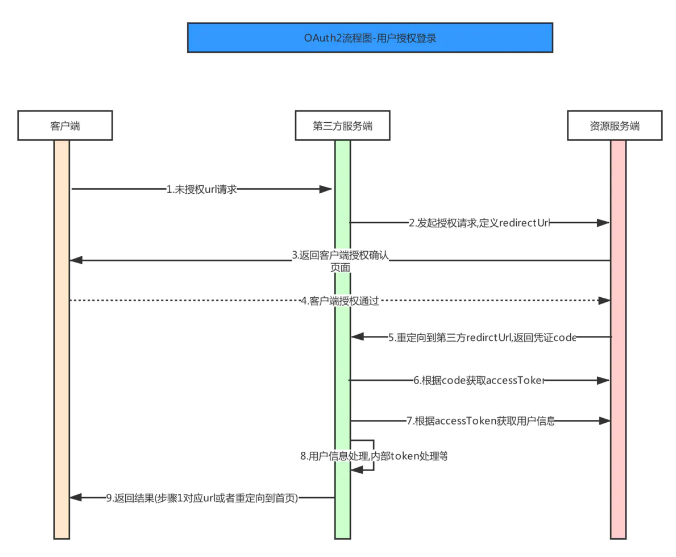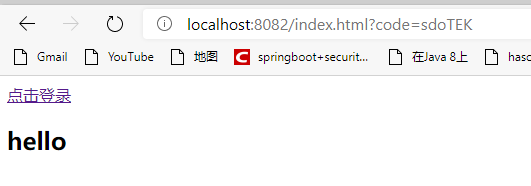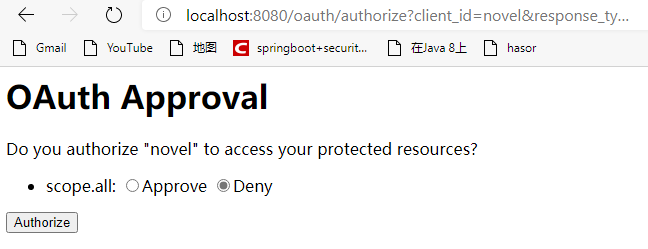springcloud、springsecurity、oatuh
Oauth协议,简单来说就是提供第三方登录,比如常见的微信登录、qq登录等。
流程大致如下:(网上copy的图,懒得画了)

- 客户端发出登录请求
- 服务端给客户端返回code
- 客户端凭借code向服务端获取accessToken
- 客户端凭借accessToken向服务端请求资源
至于oauth的介绍就这样了,有兴趣的去官方看一下:https://oauth.net/2/
一、搭建授权服务
├─auth-server │ │ │ └─src │ ├─main │ ├─java │ │ └─com │ │ └─lhf │ │ └─authserver │ │ │ AuthServerApplication.java │ │ │ │ │ └─config │ │ AuthServerConfig.java │ │ SecurityConfig.java │ │ │ └─resources │ │ application.properties │ │ application.yml │ │ │ ├─static │ └─templates │ ├─resource-server │ │ │ └─src │ ├─main │ ├─java │ │ └─com │ │ └─lhf │ │ └─resourceserver │ │ │ ResourceServerApplication.java │ │ │ │ │ ├─config │ │ │ ResourceServerConfig.java │ │ │ │ │ └─controller │ │ TestController.java │ │ │ └─resources │ │ application.yml │ │ │ ├─static │ └─templates │ └─test └─src ├─main ├─java │ └─com │ └─lhf │ └─test │ │ TestApplication.java │ │ │ └─controller │ TestController.java │ └─resources │ application.yml │ ├─static └─templates index.html
项目结构大致如上:
添加pom.xml如下
<dependency>
<groupId>org.springframework.boot</groupId>
<artifactId>spring-boot-starter-web</artifactId>
</dependency>
<dependency>
<groupId>org.springframework.cloud</groupId>
<artifactId>spring-cloud-starter-oauth2</artifactId>
</dependency>
<dependency>
<groupId>org.springframework.cloud</groupId>
<artifactId>spring-cloud-starter-security</artifactId>
</dependency>
添加配置文件SecurityConfig.java
package com.lhf.authserver.config; import org.springframework.context.annotation.Bean; import org.springframework.context.annotation.Configuration; import org.springframework.security.config.annotation.authentication.builders.AuthenticationManagerBuilder; import org.springframework.security.config.annotation.web.builders.HttpSecurity; import org.springframework.security.config.annotation.web.configuration.WebSecurityConfigurerAdapter; import org.springframework.security.crypto.bcrypt.BCryptPasswordEncoder; import org.springframework.security.crypto.password.PasswordEncoder; /** * <p></p> * * @author zy 刘会发 * @version 1.0 * @since 2020/5/11 */ @Configuration public class SecurityConfig extends WebSecurityConfigurerAdapter { /** * 密码比对器 * * @return */ @Bean public PasswordEncoder passwordEncoder() { return new BCryptPasswordEncoder(); } /** * 配置用户 * * @param auth * @throws Exception */ @Override protected void configure(AuthenticationManagerBuilder auth) throws Exception { auth.inMemoryAuthentication() .withUser("admin").password(passwordEncoder().encode("123")).roles("admin"); } /** * 安全配置 * * @param http * @throws Exception */ @Override protected void configure(HttpSecurity http) throws Exception { http.csrf().disable().formLogin(); } }
添加配置类AuthServer.java
package com.lhf.authserver.config; import org.springframework.beans.factory.annotation.Autowired; import org.springframework.context.annotation.Bean; import org.springframework.context.annotation.Configuration; import org.springframework.security.crypto.password.PasswordEncoder; import org.springframework.security.oauth2.config.annotation.configurers.ClientDetailsServiceConfigurer; import org.springframework.security.oauth2.config.annotation.web.configuration.AuthorizationServerConfigurerAdapter; import org.springframework.security.oauth2.config.annotation.web.configuration.EnableAuthorizationServer; import org.springframework.security.oauth2.config.annotation.web.configurers.AuthorizationServerEndpointsConfigurer; import org.springframework.security.oauth2.config.annotation.web.configurers.AuthorizationServerSecurityConfigurer; import org.springframework.security.oauth2.provider.ClientDetailsService; import org.springframework.security.oauth2.provider.code.InMemoryAuthorizationCodeServices; import org.springframework.security.oauth2.provider.token.DefaultTokenServices; import org.springframework.security.oauth2.provider.token.store.InMemoryTokenStore; import javax.annotation.Resource; /** * <p> * 授权服务 * </p> * * @author zy 刘会发 * @version 1.0 * @since 2020/5/11 */ @Configuration @EnableAuthorizationServer//开启授权服务自动配置 public class AuthServerConfig extends AuthorizationServerConfigurerAdapter { /** * 密码比对器 */ @Resource private PasswordEncoder passwordEncoder; @Autowired private ClientDetailsService clientDetailsService; /** * 授权安全配置 * * @param security * @throws Exception */ @Override public void configure(AuthorizationServerSecurityConfigurer security) throws Exception { security.checkTokenAccess("permitAll()").allowFormAuthenticationForClients();//开启check_token给所有权限,开启表单登录模式 } /** * 客户端配置 * * @param clients * @throws Exception */ @Override public void configure(ClientDetailsServiceConfigurer clients) throws Exception { clients.inMemory() .withClient("novel")//添加一个客户端 .secret(passwordEncoder.encode("123"))//客户端连接密码 .resourceIds("lhf")//资源id .autoApprove(true)//自动授权 .authorizedGrantTypes("authorization_code")//授权码模式 模式分为4种,除了授权码模式以外还有: PKCE 、 Client Credentials 、 Device Code 、 Refresh Token几种 .scopes("all")//作用域 .redirectUris("http://localhost:8082/index.html");//登录成功后重定向页面,可以是客户端登录页面,也可以是客户端首页 } /** * 节点配置 * * @param endpoints * @throws Exception */ @Override public void configure(AuthorizationServerEndpointsConfigurer endpoints) throws Exception { endpoints.tokenServices(defaultTokenServices()).authorizationCodeServices(inMemoryAuthorizationCodeServices()); } /** * spring security 提供的默认的token处理 * * @return */ @Bean public DefaultTokenServices defaultTokenServices() { DefaultTokenServices bean = new DefaultTokenServices(); bean.setTokenStore(inMemoryTokenStore()); bean.setClientDetailsService(clientDetailsService); bean.setAccessTokenValiditySeconds(60 * 60); bean.setRefreshTokenValiditySeconds(30 * 60); bean.setSupportRefreshToken(true); return bean; } /** * token保存方式 * * @return */ @Bean public InMemoryTokenStore inMemoryTokenStore() { return new InMemoryTokenStore(); } /** * 授权码保存方式 * * @return */ @Bean public InMemoryAuthorizationCodeServices inMemoryAuthorizationCodeServices() { return new InMemoryAuthorizationCodeServices(); } }
二、资源服务器
通常来说资源服务器和授权服务器是放到一起的(除非是特别大的项目),这里为了区分我们把它分开
maven的pom节点和授权服务一样,更改端口号为8081
添加ResourceServer.java
package com.lhf.resourceserver.config; import org.springframework.context.annotation.Bean; import org.springframework.context.annotation.Configuration; import org.springframework.security.config.annotation.web.builders.HttpSecurity; import org.springframework.security.oauth2.config.annotation.web.configuration.EnableResourceServer; import org.springframework.security.oauth2.config.annotation.web.configuration.ResourceServerConfigurerAdapter; import org.springframework.security.oauth2.config.annotation.web.configurers.ResourceServerSecurityConfigurer; import org.springframework.security.oauth2.provider.token.RemoteTokenServices; /** * <p>资源服务器</p> * * @author zy 刘会发 * @version 1.0 * @since 2020/5/11 */ @Configuration @EnableResourceServer//开启资源服务自动配置 public class ResourceServerConfig extends ResourceServerConfigurerAdapter { /** * 远程token验证,就是验证token时到授权服务验证 * @return */ @Bean public RemoteTokenServices remoteTokenServices() { RemoteTokenServices bean = new RemoteTokenServices(); bean.setClientId("novel"); bean.setClientSecret("123"); bean.setCheckTokenEndpointUrl("http://localhost:8080/oauth/check_token");//验证地址 return bean; } /** * 资源配置 * @param resources * @throws Exception */ @Override public void configure(ResourceServerSecurityConfigurer resources) throws Exception { resources.tokenServices(remoteTokenServices()) .resourceId("lhf"); } /** * 安全配置 * @param http * @throws Exception */ @Override public void configure(HttpSecurity http) throws Exception { http.authorizeRequests() .antMatchers("/**").hasRole("admin") .anyRequest().authenticated(); } }
添加测试类TestController.java
package com.lhf.resourceserver.controller; import org.springframework.web.bind.annotation.GetMapping; import org.springframework.web.bind.annotation.RestController; /** * <p></p> * * @author zy 刘会发 * @version 1.0 * @since 2020/5/11 */ @RestController public class TestController { @GetMapping("hello") public String hello() { return "hello"; } }
三、添加第三方登录服务
添加maven节点,并修改端口号为8082
<dependency>
<groupId>org.springframework.boot</groupId>
<artifactId>spring-boot-starter-thymeleaf</artifactId>
</dependency>
<dependency>
<groupId>org.springframework.boot</groupId>
<artifactId>spring-boot-starter-web</artifactId>
</dependency>
添加测试页面
<!DOCTYPE html> <html lang="en" xmlns:th="http://www.thymeleaf.org"> <head> <meta charset="UTF-8"> <title>第三方授权页面</title> </head> <body> <a href="http://localhost:8080/oauth/authorize?client_id=novel&response_type=code&scope=all&redirect_uri=http://localhost:8082/index.html">点击登录</a> <h2 th:text="${msg}"></h2> </body> </html>
http://localhost:8080/oauth/authorize: 登录请求地址
client_id: 客户端id
response_type:响应类型
scope:作用域
redirect_uri:自定义重定向地址
添加控制层
package com.lhf.test.controller; import org.springframework.http.HttpEntity; import org.springframework.http.HttpHeaders; import org.springframework.http.HttpMethod; import org.springframework.http.ResponseEntity; import org.springframework.stereotype.Controller; import org.springframework.util.LinkedMultiValueMap; import org.springframework.util.MultiValueMap; import org.springframework.web.bind.annotation.GetMapping; import org.springframework.web.client.RestTemplate; import org.springframework.web.servlet.ModelAndView; import javax.annotation.Resource; import java.util.Map; /** * <p></p> * * @author zy 刘会发 * @version 1.0 * @since 2020/5/11 */ @Controller public class TestController { @Resource private RestTemplate restTemplate; @GetMapping("/index.html") public Object index(ModelAndView mv, String code) { mv.setViewName("index"); if (code != null) {//当code不为空时,先请求token,然后拿着token请求资源 MultiValueMap<String, String> map = new LinkedMultiValueMap<>(); map.add("code", code); map.add("client_id", "novel"); map.add("client_secret", "123"); map.add("redirect_uri", "http://localhost:8082/index.html"); map.add("grant_type", "authorization_code"); Map<String, String> resp = restTemplate.postForObject("http://localhost:8080/oauth/token", map, Map.class); String access_token = resp.get("access_token"); System.out.println(access_token); HttpHeaders headers = new HttpHeaders(); headers.add("Authorization", "Bearer " + access_token); HttpEntity<Object> httpEntity = new HttpEntity<>(headers); ResponseEntity<String> entity = restTemplate.exchange("http://localhost:8081/hello", HttpMethod.GET, httpEntity, String.class); mv.addObject("msg", entity.getBody()); } return mv; } }
这里需要一个restTempalte,可以在启动类上添加一下代码:
package com.lhf.test; import org.springframework.boot.SpringApplication; import org.springframework.boot.autoconfigure.SpringBootApplication; import org.springframework.context.annotation.Bean; import org.springframework.web.client.RestTemplate; @SpringBootApplication public class TestApplication { public static void main(String[] args) { SpringApplication.run(TestApplication.class, args); } @Bean public RestTemplate restTemplate(){ return new RestTemplate(); } }
请求: http://localhost:8082/index.html

点击登录跳转登录页面

登录后可以看到获取到资源服务的接口返回值

还记得授权服务上有这么一个配置吗?
.autoApprove(true)//自动授权
把他注释掉
然后重启服务再次请求后,登录会看到授权页面

授权后才能访问资源服务上的资源
本文源码地址:
码云地址: https://gitee.com/lhfas/oauth.git
github地址: https://github.com/Liuhuifa/oauth.git




